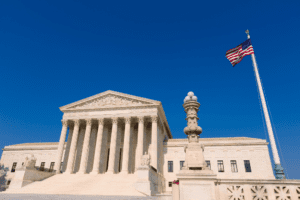 Justice Breyer continued: The Court today replaces the Courts of Appeals’ consensus framework with its own history-only approach. That is unusual. We do not normally disrupt settled consensus among the Courts of Appeals, especially not when that consensus approach has been applied without issue for over a decade. See Brief for Second Amendment Law Professors as Amici Curiae 4, 13–15; see also this Court’s Rule 10. The Court attempts to justify its deviation from our normal practice by claiming that the Courts of Appeals’ approach is inconsistent with Heller. See ante, at 10. In doing so, the Court implies that all 11 Courts of Appeals that have considered this question misread Heller. To the contrary, it is this Court that misreads Heller. The opinion in Heller did focus primarily on “constitutional text and history,” ante, at 13 (majority opinion), but it did not “rejec[t] . . . means-end scrutiny,” as the Court claims, ante, at 15.
Justice Breyer continued: The Court today replaces the Courts of Appeals’ consensus framework with its own history-only approach. That is unusual. We do not normally disrupt settled consensus among the Courts of Appeals, especially not when that consensus approach has been applied without issue for over a decade. See Brief for Second Amendment Law Professors as Amici Curiae 4, 13–15; see also this Court’s Rule 10. The Court attempts to justify its deviation from our normal practice by claiming that the Courts of Appeals’ approach is inconsistent with Heller. See ante, at 10. In doing so, the Court implies that all 11 Courts of Appeals that have considered this question misread Heller. To the contrary, it is this Court that misreads Heller. The opinion in Heller did focus primarily on “constitutional text and history,” ante, at 13 (majority opinion), but it did not “rejec[t] . . . means-end scrutiny,” as the Court claims, ante, at 15.
Consider what the Heller Court actually said. True, the Court spent many pages in Heller discussing the text and historical context of the Second Amendment. 554 U. S., at 579–619. But that is not surprising because the Heller Court was asked to answer the preliminary question whether the Second Amendment right to “bear Arms” encompasses an individual right to possess a firearm in the home for self-defense. Id., at 577. The Heller Court concluded that the Second Amendment’s text and history were sufficiently clear to resolve that question: The Second Amendment, it said, does include such an individual right. Id., at 579–619. There was thus no need for the Court to go further—to look beyond text and history, or to suggest what analysis would be appropriate in other cases where the text and history are not clear.
The dissent gives the false impression that every American who has qualified to purchase a firearm will now qualify to carry a concealed handgun. As a practical matter, the Government always has procedure as a weapon to combat a substantive law that it does not agree with. That is to say, there will still be many bases to deny permits to carry and most of the aggrieved applicants will not have the means to pursue costly appeals.
